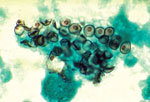
Volume 23, Number 8—August 2017
Etymologia
Etymologia: Pneumocystis jirovecii

Figure. Cysts of Pneumocystis jirovecii in smear from bronchoalveolar lavage. Methenamine silver stain. CDC/Dr. Russell K. Brynes
A genus of unicellular fungi, Pneumocystis (Figure) was likely originally described by Carlos Chagas in 1909 in guinea pigs, although he confused it with a trypanosome and placed it in a new genus, Schizotrypanum. In 1912, Delanoë and Delanoë at the Pasteur Institute published the first description of the new organism as unrelated to trypanosomes and proposed the species name P. carinii in honor of Antonio Carini.
Human Pneumocystis infections were first reported in 1942 by van der Meer and Brug, but not until 1976 did Frenkel report different morphologic and physiologic characteristics of human and rat Pneumocystis isolates. He proposed the name P. jirovecii in honor of Czech parasitologist Otto Jírovec, who reported Pneumocystis as a cause of interstitial pneumonia in infants, although this name change was not accepted by researchers at the time. When Pneumocystis was reclassified from a protozoan to a fungus, the naming convention shifted from the International Code of Zoological Nomenclature to the International Code of Botanical Nomenclature, and the species epithet was modified from jiroveci to jirovecii.
References
- Frenkel JK. Pneumocystis jiroveci n. sp. from man: morphology, physiology, and immunology in relation to pathology. Natl Cancer Inst Monogr. 1976;43:13–30.PubMed
- Hawksworth DL. Responsibility in naming pathogens: the case of Pneumocystis jirovecii, the causal agent of pneumocystis pneumonia. Lancet Infect Dis. 2007;7:3–5, discussion 5. DOIPubMed
- Stringer JR, Beard CB, Miller RF, Wakefield AE. A new name (Pneumocystis jiroveci) for Pneumocystis from humans. Emerg Infect Dis. 2002;8:891–6. DOIPubMed
- Stringer JR, Beard CB, Miller RF. Spelling Pneumocystis jirovecii. Emerg Infect Dis. 2009;15:506. DOIPubMed
- Walzer PD, Smulian AG. Pneumocystis species. In: Mandell GL, Bennett, JE, Dolin R, editors. Mandell, Douglas, and Bennett’s Principles and Practice of Infectious Disease. 7th edition. Philadelphia: Elsevier; 2010. p. 3377–90.






















.png)











No hay comentarios:
Publicar un comentario